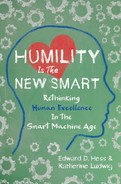Your NewSmart Organizational Assessment Tool
Organizations like Google, Pixar, Bridgewater Associates, Starbucks, United Parcel Service, Sysco, W. L. Gore & Associates, IDEO, Southwest Airlines, the US Marine Corps, and the San Antonio Spurs have built systems to drive the desired behaviors to achieve their strategic missions. All are people-centric, high-performance, high-employee-engagement organizations. We believe that people-centricity and high employee engagement are necessary to take an organization to the highest levels of human excellence. That requires Positivity, meeting employees’ Self-Determination needs, and Psychological Safety, along with a commitment to continuous iterative learning and human development.
Where do you start? Here’s what we recommend:
1. Identify the specific mindsets and behaviors that you want to enable and promote.
2. Design an organizational system that enables and promotes those behaviors. By system we mean an organization’s structure, culture, human resource policies, leadership behaviors, measurements, rewards, and processes. This system must be aligned and seamless to send consistent messages.
3. Note that processes are necessary—they facilitate self-discipline and help mitigate human autopilot tendencies.
Here’s a short-version checklist of what we believe are the key NewSmart organizational building blocks. As you read them, we suggest that you grade your organization on each item.
A = Very Good B = Good C = Fair D = Poor F = Very Poor
Culture
1. Is humanistic and people-centric
2. Enables continuous learning and personal development
3. Provides a team culture, not a “star” culture
4. Devalues elitism and hierarchy—except for compensation
5. Values candor and confronting the brutal facts
6. Serves as an idea meritocracy, with data-driven decision making
7. Provides an emotionally positive work environment
8. Ensures “permission to speak freely”
9. Imposes a duty to constructively debate, challenge the status quo, and dissent
10. Provides Psychological Safety
11. Mitigates ego
12. Mitigates fear (e.g., through postmortems, speaking up, doing learning experiments, and engaging in rigorous thinking processes)
13. Devalues knowing and values “not knowing” and how to learn
14. Favors collaboration over internal competition
15. Has a people-centric leadership model
16. Embraces Humility
17. Provides for mutual accountability
Behaviors Enabled and Encouraged
1. Humility (quiet egos)
2. Mindfulness
3. Open-mindedness
4. Empathy and compassion
5. Reflective Listening
6. Managing one’s thinking
7. Managing one’s emotions
8. Emotionally connecting, relating, and engaging with others
9. Embracing change, ambiguity, and new challenges
10. Being truthful and treating others with respect and dignity
11. Seeking feedback and striving daily to improve
12. Self-discipline
13. Mutual accountability
14. Transparent collaboration, not competition
High Employee Engagement and Development Model
1. Self-Determination needs are met.
2. Every employee has a behavioral-based personal development plan.
3. Leaders and managers are measured and rewarded for developing people.
4. Every employee has a developmental mentor who has no “power” over the employee.
Processes Used
1. Rigorous hiring for cultural fit
2. Real-time feedback
3. Transparent, fair, and consistently applied reward and promotion policies
4. Measurement of behaviors, not just financial results
5. Measurement of learning—speed and quality
6. Meeting management
7. Critical thinking
8. Creative and innovative thinking
9. Rapid Experimentation
10. Collaboration
11. Reflective Listening
12. After-action reviews
13. PreMortems
14. Mental rehearsal visualization
15. Managing fear
16. 360-degree reviews
